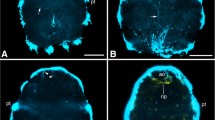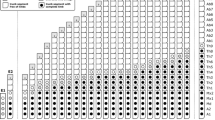Summary
The two statocysts of the veliger larva of Rostanga pulchra are positioned within the base of the foot. They are spherical, fluid-filled capsule that contain a large, calcareous statolith and several smaller concretions. The epithelium of the statocyst is composed of 10 ciliated sensory cells (hair cells) and 11 accessory cells. The latter group stains darkly and includes 2 microvillous cells, 7 supporting cells, and 2 glial cells. The hair cells stain lightly and each gives rise to an axon; two types can be distinguished. The first type, in which a minimum of 3 cilia are randomly positioned on the apical cell membrane, is restricted to the upper portion of the statocyst. The second type, in which 9 to 11 cilia are arranged in a slightly curved row, is found exclusively around the base of the statocyst. Each statocyst is connected dorso-laterally to the ipsilateral cerebral ganglion by a short static nerve, formed by axons arising from the hair cells. Ganglionic neurons synapse with these axons as the static nerve enters the cerebral ganglion. The lumen of the statocyst is continuous with a blind constricted canal located beneath the static nerve.
A diagram showing the structure of the statocyst and its association with the nervous system is presented. Possible functions of the statocyst in relation to larval behavior are discussed.
Similar content being viewed by others
References
Alkon DL, Akaike T, Harrigan J (1978) Interaction of chemosensory, visual, and statocyst pathways in Hermissenda crassicornis. J Gen Physiol 71:177–194
Barber VC (1966) The fine structure of the statocyst of Octopus vulgaris. Z Zellforsch Mikrosk Anat 70:91–107
Barber VC (1968) The structure of mollusc statocysts, with particular reference to cephalopods. Symp Zool Soc Lond 23:37–62
Barber VC, Dilly DN (1969) Some aspects of the fine structure of the statocysts of the molluscs Pecten and Pterotrachea. Z Zellforsch Mikrosk Anat 94:462–478
Bickell LR, Chia FS (1979) Organogenesis and histogenesis in the planktotrophic veliger of Doridella steinbergae (Opisthobranchia: Nudibranchia). Mar Biol 52:291–313
Bonar DN (1978) Morphogenesis at metamorphosis in opisthobranch molluscs. In: Chia FS, Rice ME (eds) Settlement and Metamorphosis of Marine Invertebrate Larvae. Elsevier/North Holland, New York, pp 177–196
Bonar DB, Hadfield MG (1974) Metamorphosis of the marine gastropod Phestilla sibogae Bergh (Nudibranchia: Aoelidacea). I. Light and electron microscope analysis of larval and metamorphic stage. J Exp Mar Biol Ecol 16:227–255
Budelmann BU (1975) Gravity receptor function in cephalopods with particular reference to Sepia officinalis. Fortschr Zool 23:84–98
Budelmann BU (1976) Equilibrium receptor systems in molluscs. In: Mill PJ (ed) Structure and Function of Proprioreceptors in the Invertebrates. Chapman and Hall, London, pp 529–566
Budelmann BU (1979) Hair cell polarization in the gravity receptor systems of the statocysts of the cephalopods Sepia officinalis and Loligo vulgaris. Brain Res 160:261–270
Budelmann BU, Barber VC, West S (1973) Scanning electron microscopical studies of the arrangements and numbers of hair cells in the statocysts of Octopus vulgaris, Sepia officinalis and Loligo vulgaris. Brain Res 56:25–41
Carter GS (1926) On the nervous control of the velar cilia of the nudibranch veliger. J Exp Biol 4:1–26
Chia FS, Koss R (1978) Development and metamorphosis of the planktotrophic larvae of Rostanga pulchra (Mollusca: Nudibranchia). Mar Biol 46:109–119
Chia FS, Atwood DG, Crawford BJ (1975) Comparative morphology of echinoderm sperm and possible phylogenetic implications. Am Zool 15:553–565
Coggeshall RE (1969) A fine structural analysis of the statocyst in Aplysia californica. J Morphol 127:113–132
Cragg SM, Nott JA (1977) The ultrastructure of the statocysts in the pediveliger larvae of Pecten maximus (L.) (Bivalvia). J Exp Mar Biol Ecol 27:23–36
Davis WJ, Mpitsos GJ (1971) Behavioral choice and habituation in the marine mollusk, Pleurobranchea californicus MacFarland. Z Vgl Physiol 75:207–232
Geuze JJ (1968) Observations on the function and the structure of the statocysts of Lymnaea stagnalis (L.). Netherl J Zool 18:155–204
Harrigan J, Crow T, Alkon D (1979) Statocyst development in Hermissenda crassicornis. Am Zool 19:1001
Lane BP, Europa DL (1965) Differential staining of ultrathin sections of Epon-embedded tissues for light microscopy. J Histochem Cytochem 13:579–581
Laverack MS (1968) On superficial receptors. Symp Zool Soc Lond 23:299–326
Mackie GO, Singla CL, Thiriot-Quievreux C (1976) Nervous control of ciliary activity in gastropod larvae. Biol Bull 151:182–199
McKee AE, Wiederhold ML (1974) Aplysia statocyst receptor cells: fine structure. Brain Res 81:310–313
Morse P (1971) Biology and life history of the nudibranch mollusc, Coryphella stimpsoni (Verrill 1879). Biol Bull 140:84–94
Raven DP (1958) Morphogenesis: The Analysis of Molluscan Development. Pergamon, London
Richardson KC, Jarrett L, Finke EH (1960) Embedding in epoxy resins for ultrathin sectioning in electron microscopy. Stain Technol 35:313–323
Rivest BR (1978) Development of the eolid nudibranch Cuthona nana (Alder and Hancock 1842), and its relationship with a hydroid and hermit crab. Biol Bull 154:157–175
Smith ST (1967) The development of Retusa obtusa (Montagu) (Gastropoda, Opisthobranchia). Can J Zool 45:737–764
Stahlschmidt V, Wolff HG (1972) The fine structure of the statocyst of the prosobranch mollusc Pomacea paludosa. Z Zellforsch Mikrosk Anat 133:529–537
Tardy J (1970) Contribution a l'étude des metamorphoses chez les nudibranches. Ann Sci Nat (Zool) 12:299–371
Thompson TE (1958) The natural history, embryology, larval biology, and post-larval development of Adalaria proximo (Alder and Hancock) (Gastropoda, Opisthobranchia). Phil Trans R Soc Lond (SerB)242:1–57
Thompson TE (1962) Studies on the ontogeny of Tritonia hombergi Cuvier (Gastropoda: Opisthobranchia). Phil Trans R Soc Lond (Ser B) 245:171–218
Tsirulis TP (1974) The fine structure of the statocyst in the gastropod Clione limacina. Zh Evolyuts Biokhim Fiziol 10:181–188
Vinnikov YA, Gazenko OG, Bronstein AA, Tsirulis TP, Ivanov VP, Pyatkina GA (1967) Structural, cytochemical and functional organization of statocysts of cephalopoda. Symp Neurobiol Invert Akademia Kiado, Budapest, pp 29–48
Wiederhold ML (1974) Aplysia statocyst receptor cells: intracellular responses to physiological stimuli. Brain Res 78:490–494
Wiederhold ML (1976) Mechanosensory transduction in “sensory” and “motile” cilia. Ann Rev Biophys Bioeng 5:39–62
Wolff HG (1969) Einige Ergebnisse zur Ultrastruktur der Statocysten von Limax maximus, Limax flavus und Arion empiricorum (Pulmonata). Z Zellforsch Mikrosk Anat 100:251–270
Wolff HG (1970) Statocystenfunktion bei einigen Landpulmonaten (Gastropoda) (Verhaltens- und elektrophysiologische Untersuchungen). Z Vgl Physiol 69:326–366
Wolff HG (1973) Multi-directional sensitivity of statocyst receptor cells of the opisthobranch gastropod Aplysia limacina. Mar Behav Physiol 1:361–373
Wolff HG (1975) Statocyst and geotactic behavior in gastropod molluscs. Fortschr Zool 23:63–84
Wood RL, Luft JH (1965) The influence of buffer systems on fixation with osmium tetroxide. J Ultrastruct Res 12:22–45
Author information
Authors and Affiliations
Rights and permissions
About this article
Cite this article
Chia, F.S., Koss, R. & Bickell, L.R. Fine structural study of the statocysts in the veliger larva of the nudibranch, Rostanga pulchra . Cell Tissue Res. 214, 67–80 (1981). https://doi.org/10.1007/BF00235145
Accepted:
Issue Date:
DOI: https://doi.org/10.1007/BF00235145




